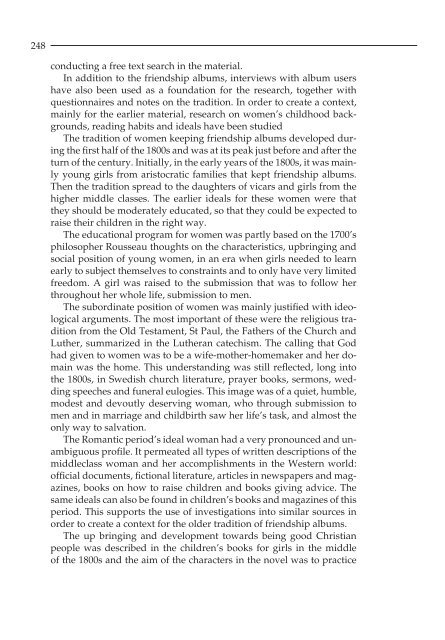Var trogen i allt - Doria
Var trogen i allt - Doria
Var trogen i allt - Doria
Create successful ePaper yourself
Turn your PDF publications into a flip-book with our unique Google optimized e-Paper software.
248<br />
conducting a free text search in the material.<br />
In addition to the friendship albums, interviews with album users<br />
have also been used as a foundation for the research, together with<br />
questionnaires and notes on the tradition. In order to create a context,<br />
mainly for the earlier material, research on women’s childhood backgrounds,<br />
reading habits and ideals have been studied<br />
The tradition of women keeping friendship albums developed during<br />
the fi rst half of the 1800s and was at its peak just before and after the<br />
turn of the century. Initially, in the early years of the 1800s, it was mainly<br />
young girls from aristocratic families that kept friendship albums.<br />
Then the tradition spread to the daughters of vicars and girls from the<br />
higher middle classes. The earlier ideals for these women were that<br />
they should be moderately educated, so that they could be expected to<br />
raise their children in the right way.<br />
The educational program for women was partly based on the 1700’s<br />
philosopher Rousseau thoughts on the characteristics, upbringing and<br />
social position of young women, in an era when girls needed to learn<br />
early to subject themselves to constraints and to only have very limited<br />
freedom. A girl was raised to the submission that was to follow her<br />
throughout her whole life, submission to men.<br />
The subordinate position of women was mainly justifi ed with ideological<br />
arguments. The most important of these were the religious tradition<br />
from the Old Testament, St Paul, the Fathers of the Church and<br />
Luther, summarized in the Lutheran catechism. The calling that God<br />
had given to women was to be a wife-mother-homemaker and her domain<br />
was the home. This understanding was still refl ected, long into<br />
the 1800s, in Swedish church literature, prayer books, sermons, wedding<br />
speeches and funeral eulogies. This image was of a quiet, humble,<br />
modest and devoutly deserving woman, who through submission to<br />
men and in marriage and childbirth saw her life’s task, and almost the<br />
only way to salvation.<br />
The Romantic period’s ideal woman had a very pronounced and unambiguous<br />
profi le. It permeated all types of written descriptions of the<br />
middleclass woman and her accomplishments in the Western world:<br />
offi cial documents, fi ctional literature, articles in newspapers and magazines,<br />
books on how to raise children and books giving advice. The<br />
same ideals can also be found in children’s books and magazines of this<br />
period. This supports the use of investigations into similar sources in<br />
order to create a context for the older tradition of friendship albums.<br />
The up bringing and development towards being good Christian<br />
people was described in the children’s books for girls in the middle<br />
of the 1800s and the aim of the characters in the novel was to practice

















